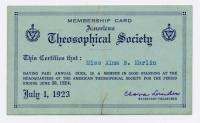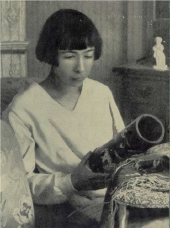Alma Karlin: Difference between revisions
No edit summary |
No edit summary |
||
| (4 intermediate revisions by the same user not shown) | |||
| Line 1: | Line 1: | ||
[[File:Alma Karlin.png|right|150px|thumb|Alma Karlin]] | [[File:Alma Karlin.png|right|150px|thumb|Alma Karlin]] | ||
'''Alma Vilibalda Maximiliana Karlin''' (12 October 1889 – 15 January 1950) was a Slovene traveler, writer, poet, collector, polyglot and theosophist. She was one of the first European women who circled the globe alone. She said to her mother on November 24, 1919, when leaving on her journey: | '''Alma Vilibalda Maximiliana Karlin''' ([[October 12|12 October]] 1889 – [[January 15|15 January]] 1950) was a Slovene traveler, writer, poet, collector, polyglot and theosophist. She was one of the first European women who circled the globe alone. She said to her mother on November 24, 1919, when leaving on her journey: | ||
I must go. Something inside me forces me to do this, and I will not find peace if I do not follow this force. | "I must go. Something inside me forces me to do this, and I will not find peace if I do not follow this force." | ||
== Personal life == | == Personal life == | ||
| Line 16: | Line 16: | ||
On January 14, 1950, Alma died in Pečovnik, Celje, Slovenia. She was buried in a graveyard in Celje, where her companion, Thea Schreinbner Gammelin was also interred in 1988.<Ref>[https://www.findagrave.com/memorial/161101762/alma-vilibalda_maximiliana-karlin Findagrave.com].</ref> | On January 14, 1950, Alma died in Pečovnik, Celje, Slovenia. She was buried in a graveyard in Celje, where her companion, Thea Schreinbner Gammelin was also interred in 1988.<Ref>[https://www.findagrave.com/memorial/161101762/alma-vilibalda_maximiliana-karlin Findagrave.com].</ref> | ||
[[File:Karlin Membership Card.jpeg|right|200px|thumb|Karlin's Membership Card]] | |||
== Theosophical Society Involvement == | == Theosophical Society Involvement == | ||
Karlin was admitted as a member of the [[American Theosophical Society]] of the Honolulu, Hawai'i Lodge on July 1, 1922. She continued as a member through June, 1924, when her address changed to "Tokio, Japan."<ref>Membership Ledger Cards. Microfilm roll 4. Theosophical Society in America Archives.</ref> | Karlin was admitted as a member of the [[American Theosophical Society]] of the Honolulu, Hawai'i Lodge on July 1, 1922. She continued as a member through June, 1924, when her address changed to "Tokio, Japan."<ref>Membership Ledger Cards. Microfilm roll 4. Theosophical Society in America Archives.</ref> | ||
<br> | |||
<br> | |||
[[File:Alma Karlin Maximiliana in Japanese dress.jpg|250px|thumb|Alma Karlin in Japanese dress]] | |||
== Travels == | |||
“If I was to be born again, I wish to be a bird so I can travel.” | |||
Karlin was one of the first women to travel the world alone. The rigid conventional expectations of her mother drove the adventurous girl away. | |||
<blockquote> | |||
At 19, she decided to make her move and escape her mother’s influence. She left for London to study at a prestigious language school. Referring to it as “voluntary exile,” she enjoyed it to the fullest. She met people from around the world and learned about their cultures. She mastered English, Spanish, French, Italian, Russian, all of the Scandinavian languages, Chinese, Sanskrit, and Latin. During her travels in Europe, she even picked up Esperanto. A personal project was a dictionary with 10 languages in one. She carried it with her everywhere she went... | |||
[[File:Alma Karlin Maximiliana | World War I forced Karlin Maximiliana to leave the UK. However, she saw this as an opportunity. She headed off on an eight-year trip around the world, taking only a suitcase of clothes, her typewriter named Erika, her trusty self-made dictionary, and a small amount of money. | ||
Karlin Maximiliana did not have generational wealth to supporther travels. She was self-made and self-sustaining, earning her way by writing for local newspapers, giving lectures, providing professional translations, and working for ambassadors in embassies. | |||
She went to South and North America, Asia, Australia, New Zealand, and the remote Pacific. She visited around 45 countries. | |||
She loved Asia most, visiting China, Japan, Taiwan, Indonesia, and Korea. Japan and China held a special place in her heart, Japanese art and customs enthralled her. The people were quite taken with her as well. She was briefly engaged to a Chinese gentleman but they broke it off. | |||
Traveling as a lone woman came with many challenges. People tried to assault her, rob her, kill her, and imprison her. Yet she persevered. | |||
She compiled a three-volume travelogue that proved very successful in the late 1920s and into the 1930s. The travelogue was translated into German and Finnish. | |||
<ref>[https://explorersweb.com/great-explorers-alma-karlin-maximiliana/ Great Explorers: Alma Karlin Maximiliana] by Kristine De Abreu. January 29, 2024.</ref> | |||
</blockquote> | |||
[[File:Alma Karlin Maximiliana.png|right|170px|thumb|Alma Karlin in her travels]] | |||
== Writings == | == Writings == | ||
| Line 35: | Line 56: | ||
* '''''The Death-Thorn: Magic, Superstitions, and Beliefs of Urban Indians in Panama and Peru'''''. Translated by Bernard Miall. London: G. Allen & Unwin, 1934. | * '''''The Death-Thorn: Magic, Superstitions, and Beliefs of Urban Indians in Panama and Peru'''''. Translated by Bernard Miall. London: G. Allen & Unwin, 1934. | ||
* '''''Drachen und Geister''''' ["Dragons and Ghosts"]. [D. Walter.], 1931. | |||
== Other resources == | == Other resources == | ||
| Line 50: | Line 72: | ||
[[Category:People|Karlin, Alma]] | [[Category:People|Karlin, Alma]] | ||
[[Category:Nationality Slovenian|Karlin, Alma]] | [[Category:Nationality Slovenian|Karlin, Alma]] | ||
[[Category:Explorers|Karlin, Alma]] | |||
[[Category:Writers|Karlin, Alma]] | [[Category:Writers|Karlin, Alma]] | ||
[[Category:Poets|Karlin, Alma]] | [[Category:Poets|Karlin, Alma]] | ||
[[Category:Fiction writers|Karlin, Alma]] | [[Category:Fiction writers|Karlin, Alma]] | ||
Latest revision as of 16:32, 21 November 2024
Alma Vilibalda Maximiliana Karlin (12 October 1889 – 15 January 1950) was a Slovene traveler, writer, poet, collector, polyglot and theosophist. She was one of the first European women who circled the globe alone. She said to her mother on November 24, 1919, when leaving on her journey:
"I must go. Something inside me forces me to do this, and I will not find peace if I do not follow this force."
Personal life
Alma Karlin was born October 12, 1889 in Celje, Slovenia to Jakob Karlin and Vilibalda Miheljak. Her father died when Alma was only eight years old.
According a biographical sketch in the Alma Karlin Memorial House website:
Alma Maximiliana Karlin was born in Celje into a bourgeois family: her father was a major in the Austrian army, her mother, a teacher. In 1908, she left for London where she found a job in a translation office and studied languages. In 1914, she graduated from the Royal Society of Arts in 8 languages. In 1919, she embarked upon her famed travels around the world, which last continuously for 8 years. For a woman travelling alone, travelling at that time was something exceptional, even outrageous. She returned to Celje in 1927.
Upon her return, she taught, still travelled a lot, gave many lectures at home and abroad, wrote for various magazines, even her own literature. From 1921 and 1937 alone, she published 22 books in Germany, Great Britain, Switzerland and Finland. Swedish writer Selma Lagerlöf (1858–1940), the first female writer to win the Nobel Prize in Literature in 1909, even proposed her for a Nobel Prize. On one of her lectures in Stockholm in the early 1930s, Alma met the painter Thea Schreibner Gammelin (1906–1988) with whom she was bound by a lasting friendship, probably also by a lesbian relationship. In 1934, Thea, her "soul sister", came to live permanently in Celje and they remained inseparable until Alma's death. After World War II, they moved together into a small house in Pečovnik, today's Memorial House.[1]
On January 14, 1950, Alma died in Pečovnik, Celje, Slovenia. She was buried in a graveyard in Celje, where her companion, Thea Schreinbner Gammelin was also interred in 1988.[2]
Theosophical Society Involvement
Karlin was admitted as a member of the American Theosophical Society of the Honolulu, Hawai'i Lodge on July 1, 1922. She continued as a member through June, 1924, when her address changed to "Tokio, Japan."[3]
Travels
“If I was to be born again, I wish to be a bird so I can travel.”
Karlin was one of the first women to travel the world alone. The rigid conventional expectations of her mother drove the adventurous girl away.
At 19, she decided to make her move and escape her mother’s influence. She left for London to study at a prestigious language school. Referring to it as “voluntary exile,” she enjoyed it to the fullest. She met people from around the world and learned about their cultures. She mastered English, Spanish, French, Italian, Russian, all of the Scandinavian languages, Chinese, Sanskrit, and Latin. During her travels in Europe, she even picked up Esperanto. A personal project was a dictionary with 10 languages in one. She carried it with her everywhere she went...
World War I forced Karlin Maximiliana to leave the UK. However, she saw this as an opportunity. She headed off on an eight-year trip around the world, taking only a suitcase of clothes, her typewriter named Erika, her trusty self-made dictionary, and a small amount of money.
Karlin Maximiliana did not have generational wealth to supporther travels. She was self-made and self-sustaining, earning her way by writing for local newspapers, giving lectures, providing professional translations, and working for ambassadors in embassies.
She went to South and North America, Asia, Australia, New Zealand, and the remote Pacific. She visited around 45 countries.
She loved Asia most, visiting China, Japan, Taiwan, Indonesia, and Korea. Japan and China held a special place in her heart, Japanese art and customs enthralled her. The people were quite taken with her as well. She was briefly engaged to a Chinese gentleman but they broke it off.
Traveling as a lone woman came with many challenges. People tried to assault her, rob her, kill her, and imprison her. Yet she persevered. She compiled a three-volume travelogue that proved very successful in the late 1920s and into the 1930s. The travelogue was translated into German and Finnish. [4]
Writings
This author was best known for the travel and fiction novels that she wrote in German. They were very popular in the 1930s. Most are available in Slovenian and German, but not English.
Fiction
- The Odyssey of a Lonely Woman. London : Victor Gollancz, 1933.
- The Spell of the South Sea. This novel in two volumes was reprinted several times, over 100,000 copies.
Nonfiction
- The Death-Thorn: Magic, Superstitions, and Beliefs of Urban Indians in Panama and Peru. Translated by Bernard Miall. London: G. Allen & Unwin, 1934.
- Drachen und Geister ["Dragons and Ghosts"]. [D. Walter.], 1931.
Other resources
- Alma Karlin in Wikipedia.
- Alma Karlin Web Portal.
- Alma Karlin Memorial House website for museum in Pečovnik, Slovenia.
- A Lonely Odyssey: The Life and Legacy of Alma M. Karlin. Posted July 7, 2023 on Orientations website.
- Gobetz, Milena. Alma Maximiliana Karlin: World-Famous Slovenian Writer, Ethnologist, Artist, and Composer. In Slovenian Heritage. Vol. 1 Willoughby Hills, Ohio: Slovenian Research Center of America, 1980.
- Vampelj Suhadolnik, Natasa. "A Lonely Odyssey: The life and Legacy of Alma M. Karlin." In Orientations Hong Kong Vol. 47, No. 3 (2016), 50-55.
Notes
- ↑ "History" in Alma Karlin Memorial House website.
- ↑ Findagrave.com.
- ↑ Membership Ledger Cards. Microfilm roll 4. Theosophical Society in America Archives.
- ↑ Great Explorers: Alma Karlin Maximiliana by Kristine De Abreu. January 29, 2024.



